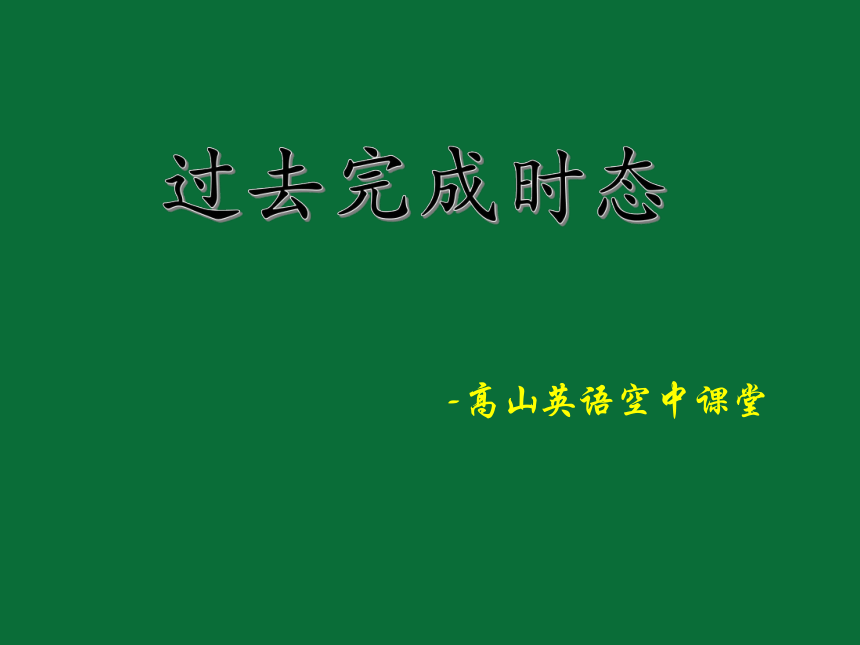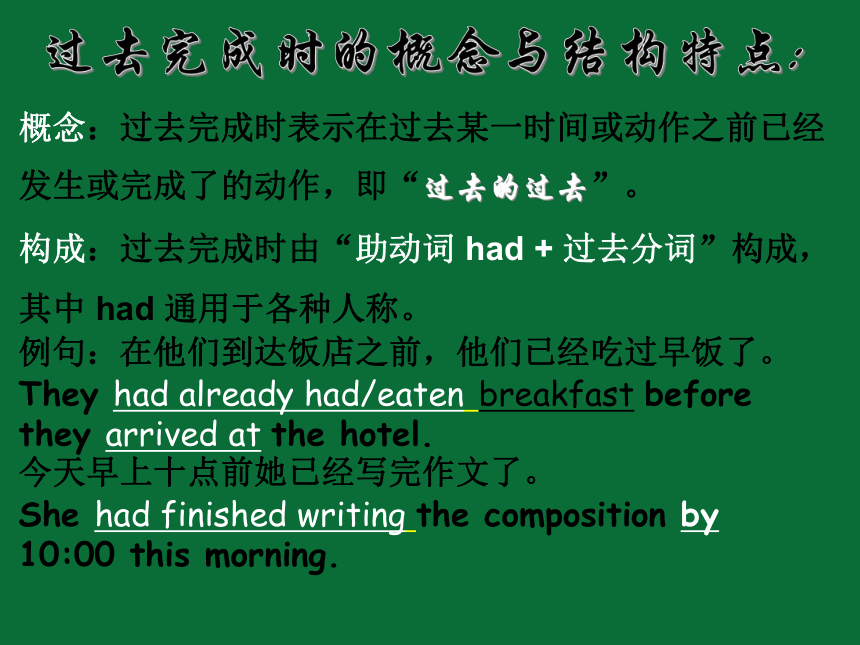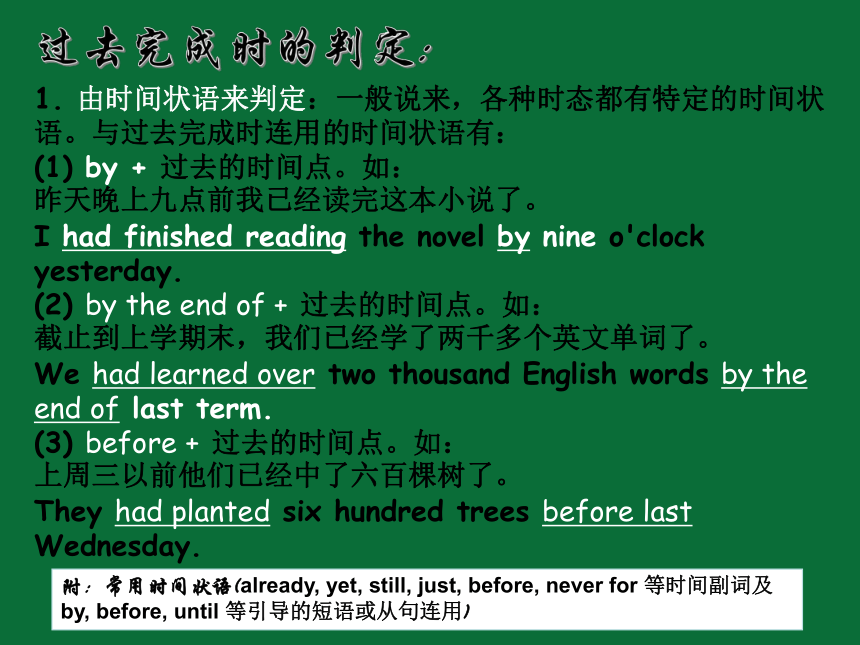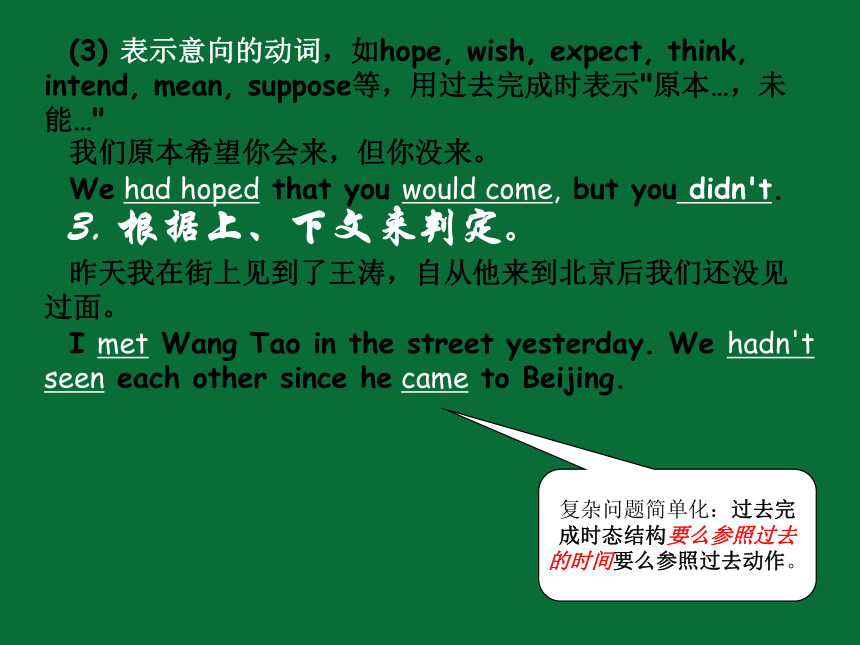中考英语语法课件:过去完成时(简化全面)
文档属性
| 名称 | 中考英语语法课件:过去完成时(简化全面) |  | |
| 格式 | pptx | ||
| 文件大小 | 12.3MB | ||
| 资源类型 | 试卷 | ||
| 版本资源 | 通用版 | ||
| 科目 | 英语 | ||
| 更新时间 | 2022-03-03 16:46:47 | ||
图片预览







文档简介
(共17张PPT)
-高山英语空中课堂
过去完成时态
过去完成时态
第一:需要储备知识点
第二:概念
第三:句子核心结构
第四:时间状语(提示词/暗示词)
第五:动词过去分词变化形式
第六:不同题型中的动词变化
过去完成时态需要储备知识点
一般过去时态相关知识点
现在完成时态相关知识点
宾语从句相关知识点
状语从句(时间、条件、原因、方式等)
过去完成时的概念与结构特点:
概念:过去完成时表示在过去某一时间或动作之前已经发生或完成了的动作,即“过去的过去”。
构成:过去完成时由“助动词 had + 过去分词”构成,其中 had 通用于各种人称。
例句:在他们到达饭店之前,他们已经吃过早饭了。
They had already had/eaten breakfast before they arrived at the hotel.
今天早上十点前她已经写完作文了。
She had finished writing the composition by 10:00 this morning.
过去完成时的判定:
1. 由时间状语来判定:一般说来,各种时态都有特定的时间状语。与过去完成时连用的时间状语有:
(1) by + 过去的时间点。如:
昨天晚上九点前我已经读完这本小说了。
I had finished reading the novel by nine o'clock yesterday.
(2) by the end of + 过去的时间点。如:
截止到上学期末,我们已经学了两千多个英文单词了。
We had learned over two thousand English words by the end of last term.
(3) before + 过去的时间点。如:
上周三以前他们已经中了六百棵树了。
They had planted six hundred trees before last Wednesday.
附:常用时间状语(already, yet, still, just, before, never for 等时间副词及 by, before, until 等引导的短语或从句连用)
2. 没有时间状语或时间状语不明显,由“过去的过去”来判定:过去完成时表示“过去的过去”,是指过去某一动作之前已经发生或完成的动作,即动作有先后关系,动作在前的用过去完成时,在后的用一般过去时。这种用法常出现在: (宾从口诀:主过从过)
(1) 宾语从句中: 当宾语从句的主句为一般过去时,且从句的动作先于主句的动作时,从句要用过去完成时。在told, said, knew, heard, thought等动词后的宾语从句。如:
她说她以前看过这电影。She said that she had seen the film before.
(2) 状语从句中: 在时间、条件、原因、方式等状语从句中,主、从句的动作发生有先后关系,动作在前的,要用过去完成时,动作在后的要用一般过去时。(强调先后顺序)如:
当我到达车站时,火车已经离开了。When I got to the station, the train had already left.
注意:before, after 引导的时间状语从句中,由于 before 和 after 本身已表达了动作的先后关系,若主、从句表示的动作紧密相连,则主、从句都用一般过去时。如:
你来这儿之前在哪儿学习?Where did you study before you came here
他关上门,离开了教室。After he closed the door, he left the classroom.
(3) 表示意向的动词,如hope, wish, expect, think, intend, mean, suppose等,用过去完成时表示"原本…,未能…"
我们原本希望你会来,但你没来。
We had hoped that you would come, but you didn't.
3. 根据上、下文来判定。
昨天我在街上见到了王涛,自从他来到北京后我们还没见过面。
I met Wang Tao in the street yesterday. We hadn't seen each other since he came to Beijing.
复杂问题简单化:过去完成时态结构要么参照过去 的时间要么参照过去动作。
动词过去分词规则变化表格
构成规则 原形 过去式 过去分词
一般变化加-ed work plant play worked planted played worked
planted
played
结尾e的动词末尾加-d like live change liked lived changed liked
lived
changed
末尾只有一个辅音字母的重读闭音节词,先双写这个辅音字母,再加-ed. plan stop drop planned stopped dropped planned
stopped
dropped
以辅音字母加y结尾的,先变y再加-ed carry study cry carried studied cried carried
studied
cried
过去分词不规则变化表格(部分)
朗读记忆动词以及过去式和过去分词。
1.be-- 2.come—
3.go-- 4.do—
5.have-- 6.drink—
7.give-- 8. eat–
9.know-- 10.make—
11.run-- 12.say—
13.see-- 14.find—
15.draw-- 16.get—
17.hear-- 18.begin—
19.buy-- 20.leave—
was/were --been
came--come
went--gone
did--done
had-had
drank--drunk
gave--given
ate--eaten
knew--known
made--made
ran--run
said--said
saw-seen
found--found
drew--drawn
got--got
heard-heard
began--begun
bought--bought
left--left
三、过去完成时的主要用法
各种不同用法归纳如下几点:
第一,“过去的过去”。
如:我醒来时,雨已经停了。(醒来在雨停后)
When I woke up, it had stopped raining.
第二. 相对应的动作或时间(过去完成时态不能离开过去的时间过相对的过去动作而独立存在)
1)He told me that he had written a new book. (had written 发生在 told 之前 ) 他告诉我他写了一本新书。
2)Peter十岁时就已经收集了三百多张中国邮票。
Peter had collected more than 300 Chinese stamps by the time he was ten.
四、过去完成时与现在完成时的区别
现在完成时与现在有关,其结构为“助动词 have (has) + 过去分词”;过去完成时则是一个相对的时态,它所表示的动作不仅发生在过去,更强调“过去的过去”,只有和过去某时或某动作相比较时,才用到它。试比较:
到目前为止我已经学会了 1000 个英语单词。
I have learned 1000 English words so far.
到那时为止我已经学会了 1000 个英语单词。
I had learned 1000 English words till then.
— I'm sorry to keep you waiting. 对不起,让你久等了。
— Oh, not at all. I have been here only a few minutes.
没什么,我只等了几分钟。(“等”的动作从过去某一时间点持续到现在)
— John returned home yesterday. 约翰昨天回到家的。
— Where had he been 他去哪儿了?(使用过去完成时是指约翰在 returned home 之前去了哪些地方,即“过去的过去”)
五 过去完成时与一般过去时的区别
虽然这两种时态都表示过去发生的动作或存在的状态,但在使用时应注意以下几点:
1. 时间状语不同:过去完成时在时间上强调“过去的过去”;而一般过去时只强调过去某一特定的时间。试比较:
他们昨天十点前就到车站了。 They had arrived at the station by ten yesterday.
他们昨天十点到了车站。 They arrived at the station at ten yesterday.
2. 在没有明确的过去时间状语作标志时,谓语动词动作发生的时间先后须依据上下文来判断:先发生的用过去完成时,后发生的则用一般过去时。如:
She was very happy. Her whole family were pleased with her, too. She had just won the first in the composition competition. (作文竞赛)
3. 当两个或两个以上接连发生的动作用 and 或 but 连接时,按时间顺序,只需用一般过去时来代替过去完成时;另外,在 before, after, as soon as引导的从句中,由于这些连词本身已经表示出时间的先后,因此也可以用过去时来代替过去完成时。如:
他进入房间,打开灯,看晚报。
He entered the room, turned on the light and read an evening paper.
我离开办公室前给她打了电话。
I (had) called her before I left the office.
I. 翻译句子:
1. 到上个月底,你看了多少部英文电影
How many English films had you seen by the end of last month
2. 今天上午十点钟前,他已完成了这项工作。
He had finished the work before ten o’clock this morning.
3. 在我妈妈回来之前,我已经完成了作业。
I had already finished my homework before my mother returned.
4. 我到运动场时,比赛已经开始了
The match had already begun when I got to the playground.
5. 八点钟,学生开始在田里劳动,这时雨已经停止,太阳出来了。
The students started working in the fields at eight o’clock. The rain had stopped and the sun was shining.
6. 在我爸爸搬到这里之前,他已在学校工作五年了。
My father had worked in the school for five years before he moved here.
7. 昨天我看到了David。自离开学校以来,我们都没有见过面。
I saw David yesterday. We had not seen each other since we left school.
8. 到六月底他们已经治疗了一万多病人。
By the end of June they had treated over 10,000 patients.
9. 他在部队干了十年,去年退役了。
He had served in the army for ten years before he retired last year.
Thanks for watching
-高山英语空中课堂
过去完成时态
过去完成时态
第一:需要储备知识点
第二:概念
第三:句子核心结构
第四:时间状语(提示词/暗示词)
第五:动词过去分词变化形式
第六:不同题型中的动词变化
过去完成时态需要储备知识点
一般过去时态相关知识点
现在完成时态相关知识点
宾语从句相关知识点
状语从句(时间、条件、原因、方式等)
过去完成时的概念与结构特点:
概念:过去完成时表示在过去某一时间或动作之前已经发生或完成了的动作,即“过去的过去”。
构成:过去完成时由“助动词 had + 过去分词”构成,其中 had 通用于各种人称。
例句:在他们到达饭店之前,他们已经吃过早饭了。
They had already had/eaten breakfast before they arrived at the hotel.
今天早上十点前她已经写完作文了。
She had finished writing the composition by 10:00 this morning.
过去完成时的判定:
1. 由时间状语来判定:一般说来,各种时态都有特定的时间状语。与过去完成时连用的时间状语有:
(1) by + 过去的时间点。如:
昨天晚上九点前我已经读完这本小说了。
I had finished reading the novel by nine o'clock yesterday.
(2) by the end of + 过去的时间点。如:
截止到上学期末,我们已经学了两千多个英文单词了。
We had learned over two thousand English words by the end of last term.
(3) before + 过去的时间点。如:
上周三以前他们已经中了六百棵树了。
They had planted six hundred trees before last Wednesday.
附:常用时间状语(already, yet, still, just, before, never for 等时间副词及 by, before, until 等引导的短语或从句连用)
2. 没有时间状语或时间状语不明显,由“过去的过去”来判定:过去完成时表示“过去的过去”,是指过去某一动作之前已经发生或完成的动作,即动作有先后关系,动作在前的用过去完成时,在后的用一般过去时。这种用法常出现在: (宾从口诀:主过从过)
(1) 宾语从句中: 当宾语从句的主句为一般过去时,且从句的动作先于主句的动作时,从句要用过去完成时。在told, said, knew, heard, thought等动词后的宾语从句。如:
她说她以前看过这电影。She said that she had seen the film before.
(2) 状语从句中: 在时间、条件、原因、方式等状语从句中,主、从句的动作发生有先后关系,动作在前的,要用过去完成时,动作在后的要用一般过去时。(强调先后顺序)如:
当我到达车站时,火车已经离开了。When I got to the station, the train had already left.
注意:before, after 引导的时间状语从句中,由于 before 和 after 本身已表达了动作的先后关系,若主、从句表示的动作紧密相连,则主、从句都用一般过去时。如:
你来这儿之前在哪儿学习?Where did you study before you came here
他关上门,离开了教室。After he closed the door, he left the classroom.
(3) 表示意向的动词,如hope, wish, expect, think, intend, mean, suppose等,用过去完成时表示"原本…,未能…"
我们原本希望你会来,但你没来。
We had hoped that you would come, but you didn't.
3. 根据上、下文来判定。
昨天我在街上见到了王涛,自从他来到北京后我们还没见过面。
I met Wang Tao in the street yesterday. We hadn't seen each other since he came to Beijing.
复杂问题简单化:过去完成时态结构要么参照过去 的时间要么参照过去动作。
动词过去分词规则变化表格
构成规则 原形 过去式 过去分词
一般变化加-ed work plant play worked planted played worked
planted
played
结尾e的动词末尾加-d like live change liked lived changed liked
lived
changed
末尾只有一个辅音字母的重读闭音节词,先双写这个辅音字母,再加-ed. plan stop drop planned stopped dropped planned
stopped
dropped
以辅音字母加y结尾的,先变y再加-ed carry study cry carried studied cried carried
studied
cried
过去分词不规则变化表格(部分)
朗读记忆动词以及过去式和过去分词。
1.be-- 2.come—
3.go-- 4.do—
5.have-- 6.drink—
7.give-- 8. eat–
9.know-- 10.make—
11.run-- 12.say—
13.see-- 14.find—
15.draw-- 16.get—
17.hear-- 18.begin—
19.buy-- 20.leave—
was/were --been
came--come
went--gone
did--done
had-had
drank--drunk
gave--given
ate--eaten
knew--known
made--made
ran--run
said--said
saw-seen
found--found
drew--drawn
got--got
heard-heard
began--begun
bought--bought
left--left
三、过去完成时的主要用法
各种不同用法归纳如下几点:
第一,“过去的过去”。
如:我醒来时,雨已经停了。(醒来在雨停后)
When I woke up, it had stopped raining.
第二. 相对应的动作或时间(过去完成时态不能离开过去的时间过相对的过去动作而独立存在)
1)He told me that he had written a new book. (had written 发生在 told 之前 ) 他告诉我他写了一本新书。
2)Peter十岁时就已经收集了三百多张中国邮票。
Peter had collected more than 300 Chinese stamps by the time he was ten.
四、过去完成时与现在完成时的区别
现在完成时与现在有关,其结构为“助动词 have (has) + 过去分词”;过去完成时则是一个相对的时态,它所表示的动作不仅发生在过去,更强调“过去的过去”,只有和过去某时或某动作相比较时,才用到它。试比较:
到目前为止我已经学会了 1000 个英语单词。
I have learned 1000 English words so far.
到那时为止我已经学会了 1000 个英语单词。
I had learned 1000 English words till then.
— I'm sorry to keep you waiting. 对不起,让你久等了。
— Oh, not at all. I have been here only a few minutes.
没什么,我只等了几分钟。(“等”的动作从过去某一时间点持续到现在)
— John returned home yesterday. 约翰昨天回到家的。
— Where had he been 他去哪儿了?(使用过去完成时是指约翰在 returned home 之前去了哪些地方,即“过去的过去”)
五 过去完成时与一般过去时的区别
虽然这两种时态都表示过去发生的动作或存在的状态,但在使用时应注意以下几点:
1. 时间状语不同:过去完成时在时间上强调“过去的过去”;而一般过去时只强调过去某一特定的时间。试比较:
他们昨天十点前就到车站了。 They had arrived at the station by ten yesterday.
他们昨天十点到了车站。 They arrived at the station at ten yesterday.
2. 在没有明确的过去时间状语作标志时,谓语动词动作发生的时间先后须依据上下文来判断:先发生的用过去完成时,后发生的则用一般过去时。如:
She was very happy. Her whole family were pleased with her, too. She had just won the first in the composition competition. (作文竞赛)
3. 当两个或两个以上接连发生的动作用 and 或 but 连接时,按时间顺序,只需用一般过去时来代替过去完成时;另外,在 before, after, as soon as引导的从句中,由于这些连词本身已经表示出时间的先后,因此也可以用过去时来代替过去完成时。如:
他进入房间,打开灯,看晚报。
He entered the room, turned on the light and read an evening paper.
我离开办公室前给她打了电话。
I (had) called her before I left the office.
I. 翻译句子:
1. 到上个月底,你看了多少部英文电影
How many English films had you seen by the end of last month
2. 今天上午十点钟前,他已完成了这项工作。
He had finished the work before ten o’clock this morning.
3. 在我妈妈回来之前,我已经完成了作业。
I had already finished my homework before my mother returned.
4. 我到运动场时,比赛已经开始了
The match had already begun when I got to the playground.
5. 八点钟,学生开始在田里劳动,这时雨已经停止,太阳出来了。
The students started working in the fields at eight o’clock. The rain had stopped and the sun was shining.
6. 在我爸爸搬到这里之前,他已在学校工作五年了。
My father had worked in the school for five years before he moved here.
7. 昨天我看到了David。自离开学校以来,我们都没有见过面。
I saw David yesterday. We had not seen each other since we left school.
8. 到六月底他们已经治疗了一万多病人。
By the end of June they had treated over 10,000 patients.
9. 他在部队干了十年,去年退役了。
He had served in the army for ten years before he retired last year.
Thanks for watching
同课章节目录
- 词法
- 名词
- 动词和动词短语
- 动词语态
- 动词时态
- 助动词和情态动词
- 非谓语动词
- 冠词
- 代词
- 数词和量词
- 形容词副词及其比较等级
- 介词和介词短语
- 连词和感叹词
- 构词法
- 相似、相近词比较
- 句法
- 陈述句
- 一般疑问句和否定疑问句
- 特殊疑问句及选择疑问句
- 反意疑问句
- 存在句(There be句型)
- 宾语从句
- 定语从句
- 状语从句
- 主谓一致问题
- 简单句
- 并列句
- 复合句
- 主谓一致
- 主、表语从句
- 名词性从句
- 直接引语和间接引语
- 虚拟语气
- 感叹句
- 强调句
- 倒装句
- 祈使句
- 句子的成分
- 句子的分类
- 题型专区
- 单项选择部分
- 易错题
- 完形填空
- 阅读理解
- 词汇练习
- 听说训练
- 句型转换
- 补全对话
- 短文改错
- 翻译
- 书面表达
- 任务型阅读
- 语法填空
- 其他资料
